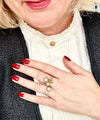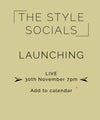Recent Post
Archive
- December 2023
- May 2023
- April 2023
Tags

How to breathe new life into your jewellery
Jun 06, 2023
We all have one don’t we? A drawer or box with forgotten, broke, don’t like it, inherited jewellery – a mix of precious metals, real gemstones, glass beads and bits, lots of bits, the stuff that we don’t quite know what it is or what to do with it. So, there it sits, year after year.
We are getting used to recycling clothes so why not jewellery? Whether it’s about falling in love with pieces again, mending, reimagining, or them letting go so they can start a new story with someone else.
Here are our top tips on recycling your jewellery:
Okay, let’s sort out the muddle.
So you can make the best decisions, it’s good to know what your jewellery is made from.
First, look to see if there is a stamp.
For Sterling Silver you can see 925, 958, 800, 999 – these numbers tell you how much is made from pure silver. To find out more about the different types of silver you can read our blog here
What metals are good and what metals are bad?
Metals that jewellers come in contact with include gold, copper, silver, zinc, iron, steel, platinum, palladium, rhodium, iridium, titanium, niobium, aluminum and ones that we should consider not having around any more at all in the workshop: nickel, lead, mercury, chromium, selenium, cadmium, arsenic, antimony.
The Magnet Test
If your magnet sticks strongly to the piece, it has a ferromagnetic core and is not silver. Fake silver or silver-plated items are generally made of other metals. This is an easy test that can give you a good idea on whether your item is real silver or not.
Many common metals such as aluminum, copper, brass, gold, silver, titanium, tungsten, and lead are not ferromagnetic. They cannot be made into magnets and will not be attracted to magnetic fields.

Things to look out for when buying or repurposing jewellery
Be careful with cheap jewellery, it’s cheap for a reason. High levels of lead have been found in jewellery, especially inexpensive children's jewellery. This toxic metal doesn't break down in the environment and accumulates in our body.
If you want to make sure your jewellery is safe, look for materials that are known to be non-toxic, including:
- 100% gold.
- 100% silver.
- Surgical-implant grade stainless steel.
- Vermeil (a type of plating that uses pure gold or silver)
- Non-metal substances such as leather, fabric, or glass beads
Want an expert to tell you what your jewellery is made from?
Contact Sell your Gold here
Maybe you know what some or all of your pieces are made from, here are some options on what to do next:
1. How to treat tarnished jewellery
If you have jewellery lying around in a drawer because it has gone dull and tarnished why not brighten it up with a jewellery cleaning cloth, you can buy these easily for gold and silver jewellery – a quick rub and it should be good as new. If the item doesn’t shine up as you would like it take it or send it off to get professionally cleaned, this will bring back new life into your pieces.
If you want to keep the tarnish away and have quite a lot of jewellery for around £30 you can invest in your own ultrasound jewellery cleaner.
Shop the Ultra Sound Jewellery Cleaner here
Shop Gold cleaning cloths here
Shop Silver cleaning cloths here
2. What to do when your gold plating has worn off
Your gold plate has faded from a much-loved piece and you have stopped wearing it.
Why not get it re-plated? You need to ask for 18 carat gold and a thickness of 3 microns is preferable for a ring, you may be able to get away with two microns but it may not last as long. For other types of jewellery 2 microns should be enough depending on how often you wear it and how you treat your pieces.
For good re-platers try The Jewellery Chap here
Also look at DMJ Jewellery here
3. How and where to sell your jewellery
We know what it’s like, sometimes you feel like you have finished your journey with a piece and rather than it lying in your drawer it could be sold and melted down and made into something else for someone else.
If you know what metal your jewellery is you can find out the value here, it’s always one by weight and carat.
Again The Jewellery Chap offers this service here
4. You’d like to get your jewellery recycled into something else that’s more your taste
No problem, we recommend Julian Stephens in Brighton. You can find him here and also Louise Sinclair is great, she created my wedding ring for me – many years ago. It was my first jewellery design ever, you can find out more about Louise here
5. My jewellery is broken and it’s just sitting in a box
It’s tricky to get jewellery repaired if you don’t know where to go, it’s one of those things that you think you’ll get round to doing some day and it never happens and then it’s forgotten about as jewellery is small and tends to be in a box at the back of a drawer.
Want to bring it back to life?
Try the following companies:
By Post Watch and Jewellery Repairs here
Fine Matter here
Jewellery Doctor here
If you fancy learning a new skill look up The Repair Café here
Hands on giving your jewellery a new life. Tag us so we can see what you do #handsonsarahverity
← Older Post Newer Post →




